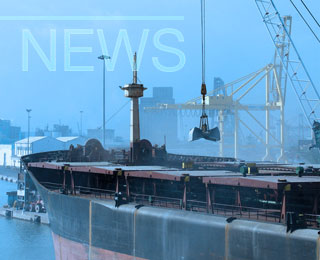While the Cape shipping sector has been showing a modest rebound over the past two weeks, lower down the scale the reality is one of continuing bargain basement prices, despite some evidence of increasing trade flows in the grain sectors. Reported announcements by Chinese government leaders to provide significant levels of support to nine key industrial areas also provides grounds for optimism in the shipping sectors, although offsetting such news are moves by Japanese steel mills to implement some drastic pruning in production – a certain dampener for import coal trades and some steel exports.
In the light of such news its perhaps not surprising that Rio Tinto has now scaled back its expansion plans in Brazil with the indefinite postponement of the Corumba iron ore mine development slated to produce 12.8Mt by 2010 against a current 2Mt.
Panamax daily front-haul rates moved up to the US$8000 level for US Gulf grain trades while similar Atlantic R/V rates were also up marginally at over the US$5100 level on fixtures reported week-ending the 10th January. There were also a number of one year period deals concluded in the mid 12’s, and short periods done at around US$8,500/day.
The Handy/Supramax sector is now hopefully at floor levels after several weeks of continuous fall. But business is still slow to emerge and there is no clear sign of a market moving up. Pacific R/Vs for Supramax tonnage are still hovering below the US$5000s’, pretty much the same for Atlantic rounds. Trips to China are being fixed in the region of US$10,000 depending on vessel’ specs. Handy-sizes are also facing a difficult situation and owners are on the look-out for any kind of trades that will keep their tonnage on the move. Period charter is still slow although some interest is becoming apparent according to Paris-based brokers Barry Rogliano.
Rather worryingly as many as half of publicly traded commodity shipping lines may breach their loan covenants by April after a record collapse in hire rates, according to Royal Bank of Scotland Group Plc, the third-largest lender to the industry. The cost of second-hand Capesizes, the largest group of commodity carriers, plunged 70 per cent last year, according to the Baltic Exchange in London. Fleet values are one of the key covenants used. Banks review loans as often as every quarter, Lambros Varnavides, the bank’s head of credit to the shipping industry, said in interviews in London mid-Jan.
“It’s hard to avoid a breach when asset values have fallen so significantly,” said Varnavides, who is global head of shipping. Assuming rates and values don’t rebound in the next several months, shippers in breach of covenants will likely have to renegotiate loans, he said.
The Baltic Dry Index, a measure of shipping costs for commodities, slumped 92 per cent last year, causing at least four ship owners to fail since October. Demand for raw materials has plunged as Europe, Japan and the US entered their first simultaneous recessions since World War II.
In terms of new orders for tonnage, most global shipyards are lowering their annual targets for orders one after another. None more so than in South Korea where Samsung Heavy Industries disclosed on Tuesday that it planned to win only US$10 billion worth of orders for vessels, which is a 33.3 percent downward adjustment from the US$15 billion set as the company’s target in 2008. Daewoo Shipbuilding and Marine Engineering, which had marked US$17.5 billion as its targeted amount for orders last year, has now set its annual target at ‘more than US$10 billion.’ Hyundai Heavy Industries has yet to finalize its target for orders this year, but the dominant view in the industry is that the amount will be lowered considerably from the target put forth a year ago.
On a brighter note shipowners are now scrapping much higher volumes of obsolete tonnage which in today’s markets are now failing to find any useful employment. According to figures compiled by Athens-based George Moundreas & Co. the average weekly volumes of dry bulk tonnage that left the market for scrap was increased at 600,000 dwt, versus 400,000-500,00 during the previous weeks. Further to that, the broker reports that negotiations are currently taking place for the scrapping of at least 157 vessels with a capacity of a stunning 5.5 million dwt. This could mean that by the end of 2009 a “healthy” 10 percent of the global dry bulk tonnage may have exited the market.
At the same time, what’s rather encouraging is that scrap prices remain at a healthy $250-275/ldt. Of course, reports for the demolition market have indicated, with reference at breakers in the Indian subcontinent, that these prices will somewhat soften. Nevertheless, India seems to be buying tonnage more aggressively than any other at the moment, while China is hovering between $215-220 per ldt. The swift response of ship owners to current market conditions has helped alleviate the supply/demand balance which at the moment favors those standing from the “demand’s” point of view.
According to Drewry Shipping in London, a total of 2704 ships were demolished up until the end of November. In fact all of these ships were sold for scrap from August onwards, since up to then only minimal amounts of tonnage vessels had left the market reports Hellenic Shipping News.
Published under Cement News


